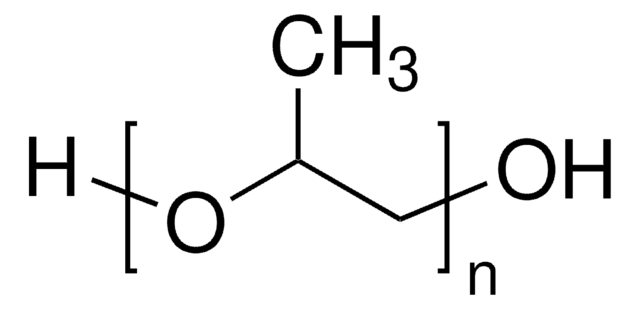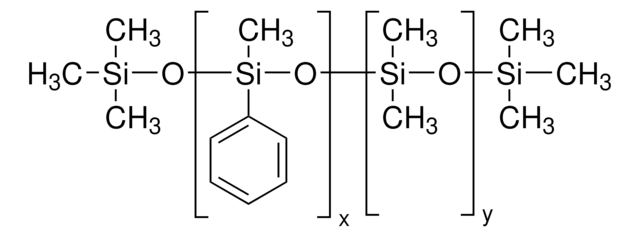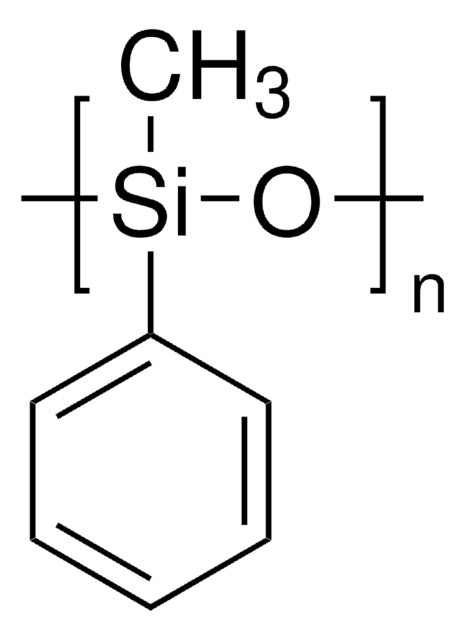923974
Bio-based Polyether Polyol
Mn 900-1100 Da
Synonym(s):
1,3-propanediol, Bio-based PPD, Homo polymer, PO3G POLYPROPANEDIOL
About This Item
Recommended Products
mol wt
Mn 900-1100 Da
Quality Level
greener alternative product characteristics
Design for Energy Efficiency
Use of Renewable Feedstocks
Learn more about the Principles of Green Chemistry.
concentration
500 ppm in water (QM-AA 1020-114)
viscosity
200-300 mPa.s(40 °C)
mp
12-14 °C
density
1.018 g/cm3 at 40 °C
greener alternative category
Looking for similar products? Visit Product Comparison Guide
General description
Application
It is hydrolysis resistant, has a high oxidative stability and a high thermal capacity, which offers a long durability in end use applications. Among its potential applications:
- High-performance elastomers - High-performace alternative to petroleum-based ingredients used in polyurethane , copolyamides and copolyesters elastomers. It allows an easy drop-in, soft-segment replacement for PTMEG thermoplastic elastomers, offering unique characteristics including good chemical resistance, high mechanical strength and toughness as well as increased softness and elastic recovery. Recently, a study showed that bio-based polypropanediol can be used for selective debonding of polyurethane-based adhesives at the end of their lifetime to facilitate the recycling of expensive components and raw materials from complex devices such as consumer electronics .
- Coatings - It can be used as ingredient or additive for auto refinish, industrial metal coatings and PU dispersions in any or all of the coating layers, replacing any petroleum-based polyols. It provides excellent adhesion to metal, and offers outstanding color dispersion and chip resistance. When used as an additive in clear coating, it provides increased flexibility and improved gravel and flake resistance.
- Ink-jet inks - When added to pigment-based ink-jet ink formulations, it combine the depth and clarity properties of dyes with the inherent durability of pigments.
- Functional fluids - Thanks to its thermal conductivity, thermal stability and lubricity, excellent low temperature properties as well as low toxicity and inherent biodegradability, it is an ideal base fluid for lubricants, dielectric coolants and heat-transfer fluids.
- Footwear and performance textile - Thanks to its superior abrasion resistance and Moisture Vapour Transmission Rate (MVTR), it offers applications in footwear and performance textile applications including synthetic leather.
Preparation Note
- Before usage, please keep the container sealed and stored at ambient temperature (5-25°C).
- For usage, it is recommended to work under nitrogen atmosphere.
- In case it has to be molten, please do it at temperatures below 70°C and under nitrogen atmosphere.
- Conditions for safe storage, including any incompatibilities: Keep containers tightly closed in a cool, well-ventilated place. Store in original container and keep them away from heat and sources of ignition. Keep under nitrogen. Also keep away from food, drink and animal feedingstuffs.
Storage Class Code
10 - Combustible liquids
WGK
WGK 3
Flash Point(F)
Not applicable
Flash Point(C)
Not applicable
Choose from one of the most recent versions:
Certificates of Analysis (COA)
Don't see the Right Version?
If you require a particular version, you can look up a specific certificate by the Lot or Batch number.
Already Own This Product?
Find documentation for the products that you have recently purchased in the Document Library.
Our team of scientists has experience in all areas of research including Life Science, Material Science, Chemical Synthesis, Chromatography, Analytical and many others.
Contact Technical Service


![Poly[trimethylolpropane/di(propylene glycol)-alt-adipic acid/phthalic anhydride], polyol average Mn ~500](/deepweb/assets/sigmaaldrich/product/structures/754/225/6e993d83-6b18-473b-a939-bb203d2680fa/640/6e993d83-6b18-473b-a939-bb203d2680fa.png)



